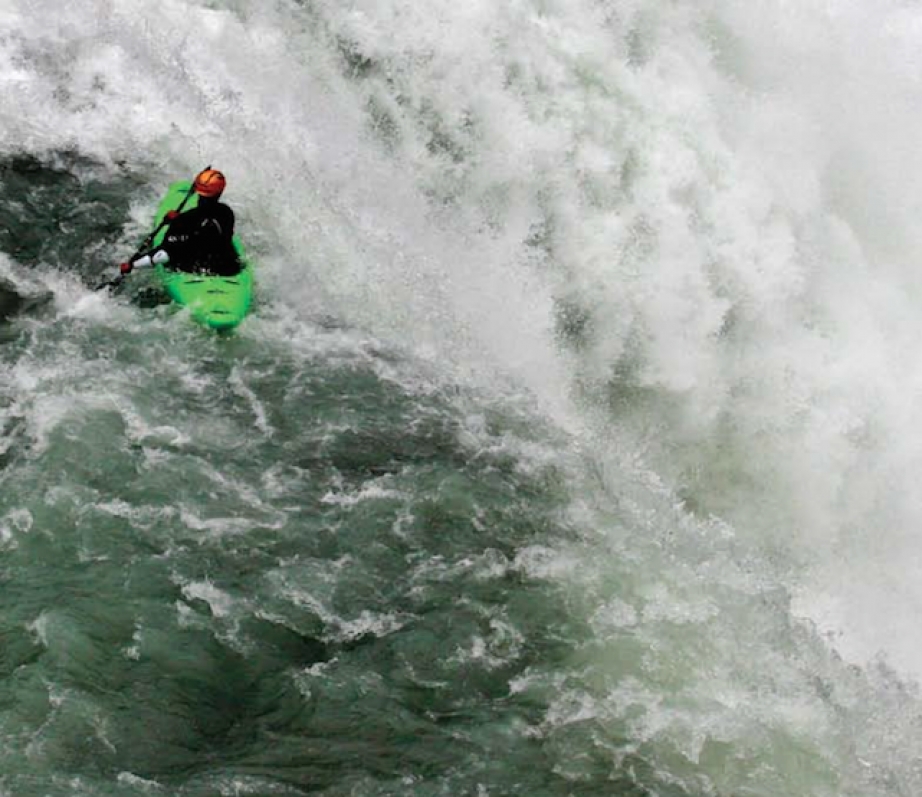On July 13, 2009, Scott Feindel and three other experienced paddlers kayaked off 98-foot Wapta falls on the Kicking Horse River, a popular tourist attraction inside B.C.’s Yoho National Park. The group hiked in 25 minutes for a preliminary scout, decided the 490-foot-wide drop warranted a closer look and put in 15 minutes upstream. After scouting thoroughly both up- and downstream from both sides of the river, two paddlers ran the falls. Scott Feindel lined up the lip next.
I’ve spent thousands of days on the river instructing, playing, completing as a member of the Canadian Freestyle Team and creeking on day trips, multi-days and expeditions.
That afternoon, I watched Jakub Nemec and Chris McTaggart make first and second ever descents of Wapta Falls. I remember scouting extensively, walking back and getting into my boat. I think I remember seal launching into the water and ferrying out to the lip. After that I don’t remember anything until several days later in the hospital.
THE INCIDENT

Due to the width of the river, my main concern was being off line. As we had discussed, the team alerted me when I was off, but due to the speed and character of the river, I was unable to get on line. I dropped 70 feet to a rock shelf and was ejected from my boat for the remaining 30 feet. Jacub and Chris pulled me, unconscious, from the class I water below.
I owe my life to the level-headed efforts of all my paddling crew. They alerted rescue using a SPOT GPS messenger and hiked out to a road construction first aid site where Ryan Galleger notified RCMP, then hiked oxygen back in for me.
My friends immobilized me and froze their asses off at the base of the falls for two and a half hours. Marc Ledwidge and Aaron Beardmore from Banff, Yoho and Kootenay National Parks Visitor Safety Program strapped me into a rescue basket that was flown out by Alpine Helicopters pilot Lance Cooper. From the accident site I was airlifted to another helicopter waiting nearby to fly me to Golden Hospital’s emergency room.
THE EXTENT OF THE INJURIES
Once stabilized in the Golden ER, I was transported by STAR’s air ambulance to Calgary’s Foothills Hospital. I spent several days in emergency, four weeks in trauma, and over four weeks in rehabilitation before being granted early release for uncooperative behavior.
I fractured my T12 vertebra, broke 15 other bones, collapsed my right lung and partially collapsed my left, and suffered a severe concussion when my brain collided with the front of my skull.
At first I was wasted on morphine, oxycontin and oxycodone, but the rehabilitation weeks were long. Meanwhile, close friends and family had to deal with the initially unknown extent of my injuries—whether I would be able to walk, and if my long-term mental capacity had been affected. My sister Shannon and good friend David were in emergency when my first purposeful words were a smart-ass remark in David’s ear, which I think alleviated some early stress.
THE EFFECTS OF THE ACCIDENT
I’ve been very fortunate to have a full recovery. The experience has taught me many important life lessons, and that the decisions I make on the river affect the people I care deeply about. I have always felt that the risks and consequences were mine alone to bear, but seeing the stress and heartache that I put my loved ones through, as well as the potential long-term care that might have been needed, I realize this is simply not the case.
I would not have run Wapta if I didn’t feel I had the skill and base of experience to do so safely. I have no regrets, but simply wish to thank those that helped me, and hope that others can learn from my mistakes to safely achieve their goals.
SPINAL INJURY 101
- Broken bones account for nine per sent of acute whitewater paddling injuries and are most common in the back, chest and ankles.
- 33 vertebrae in four regions – cervical, thoracic, lumbar and pelvic – make up the spinal column.
- If a spinal injury is suspected, lay the victim on an even surface on his back and immobilize the cervical spine (C-spine) with a cervical collar or rolled up towel or foam pad.
- Among acute injuries have the longest duration of recovery and effect on paddling.
- Shallow, rocky rapids and significant vertical drops pose high risks for head, neck and back injuries.
Scott Feindel would like to thank his paddling crew, Parks Canada Safety, Alpine and CMH Helicopters, STARS Air Ambulance, RCMP, Ryan Galleger, Golden emergency, the folks at Foothills Hospital and Bodhi Tree Yoga for helping with recovery. Most of all, he thanks his sister Shannon and friends and family for their love and support.
This article first appeared in the Summer/Fall 2010 issue of Rapid Magazine. For more great content, subscribe to Rapid’s print and digital editions here.



